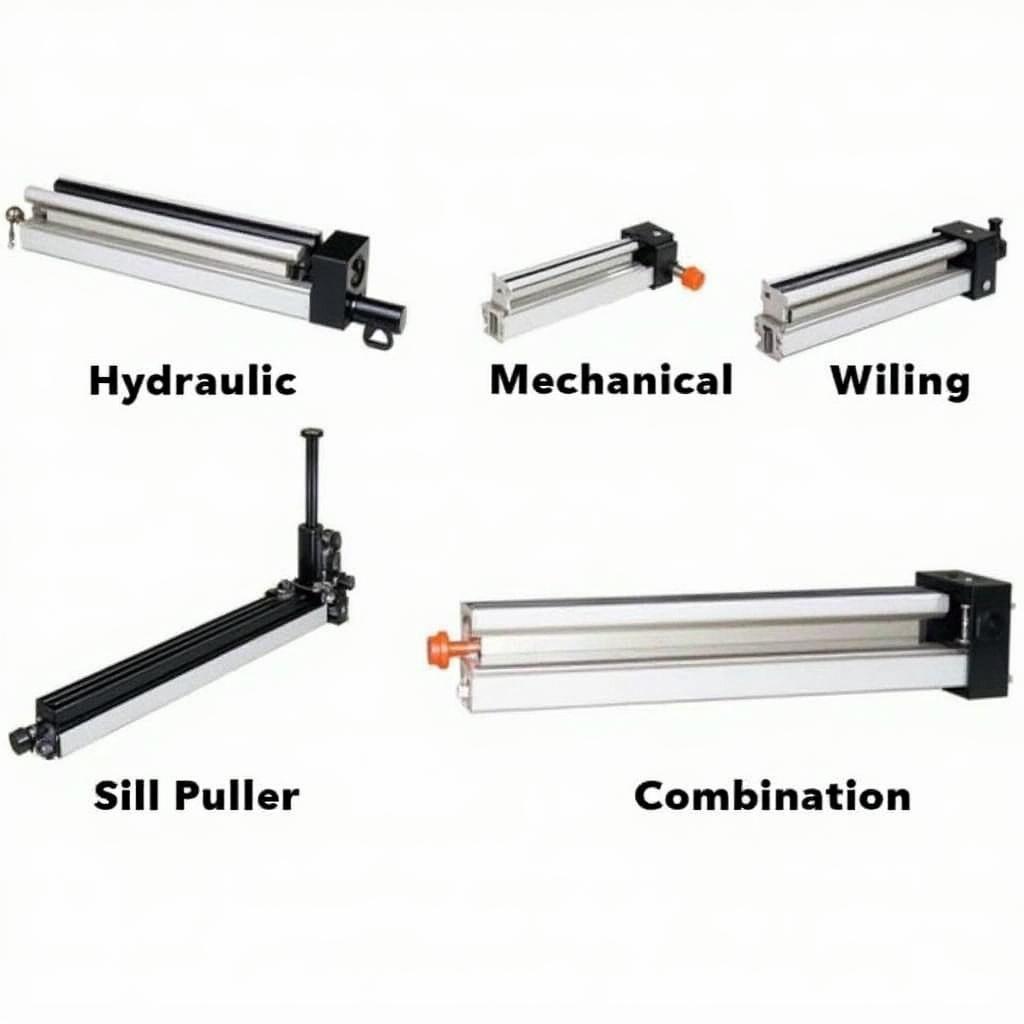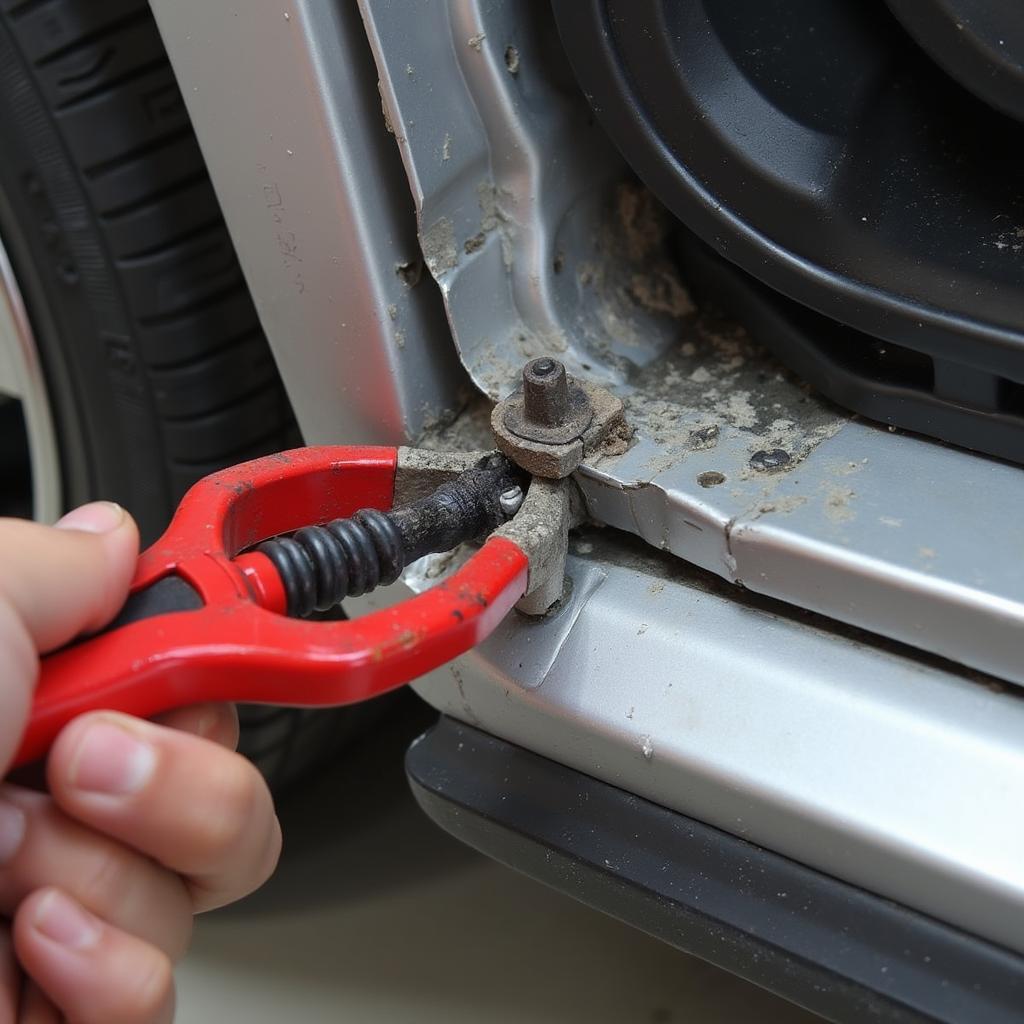
Types of Sill Pullers
Car body repair often involves dealing with damage to the sill, a crucial structural component running along the bottom of the car doors. Whether it’s a minor dent or a significant bend, a sill puller can be the tool that restores your car’s structural integrity. But what exactly is a sill puller, and how does it work its magic in car body repair?
What is a Car Body Repair Sill Puller?
A Car Body Repair Sill Puller, also known as a sill clamp or pinch weld clamp, is a specialized tool designed to straighten bent or damaged car sills. This essential piece of equipment utilizes hydraulic pressure or mechanical force to pull the damaged sill back into its original position.
 Types of Sill Pullers
Types of Sill Pullers
How Does a Sill Puller Work?
The operation of a sill puller hinges on the principle of leverage and pulling force. Here’s a breakdown of the process:
- Assessment: The damaged sill is assessed to determine the extent and location of the damage.
- Attachment: The sill puller is securely attached to the damaged area and a pulling point. This often involves welding or clamping the puller in place.
- Pulling Force: Hydraulic pressure or mechanical force is applied, gradually pulling the damaged sill outward.
- Monitoring: The progress is carefully monitored to ensure the sill is being pulled back to its correct alignment.
- Refinement: Adjustments are made as needed to achieve the desired shape and alignment.
 Car Body Repair Using a Sill Puller
Car Body Repair Using a Sill Puller
Types of Car Body Repair Sill Pullers
Various types of sill pullers are available, each with its pros and cons:
- Hydraulic Sill Pullers: These powerful pullers use hydraulic pressure for pulling force, making them ideal for heavy-duty repairs.
- Mechanical Sill Pullers: Operated manually, these pullers are simpler and less expensive, suitable for lighter repairs.
- Combination Sill Pullers: Offering both hydraulic and mechanical operation, these pullers provide versatility for different repair scenarios.
Benefits of Using a Car Body Repair Sill Puller
Using a sill puller in car body repair offers several advantages:
- Precision: Provides controlled and precise pulling force, minimizing the risk of further damage.
- Efficiency: Speeds up the repair process compared to traditional hammering and dolly techniques.
- Versatility: Effective on various types and severities of sill damage, from minor dents to major bends.
- Cost-Effective: Helps avoid costly replacement of the entire sill in many cases.
Choosing the Right Car Body Repair Sill Puller
Selecting the appropriate sill puller depends on several factors:
- Severity of Damage: Hydraulic pullers are better suited for extensive damage, while mechanical ones might suffice for minor dents.
- Budget: Consider your budget, as hydraulic pullers tend to be more expensive than their mechanical counterparts.
- Frequency of Use: If you’re a professional, investing in a durable and versatile puller is crucial.
Safety Precautions When Using a Car Body Repair Sill Puller
- Always wear appropriate safety gear, including gloves and eye protection.
- Ensure the puller is securely attached to prevent slippage during operation.
- Apply pulling force gradually and monitor the progress closely.
- Never exceed the manufacturer’s recommended pulling capacity.
- Work in a well-ventilated area, especially when using welding equipment.
Conclusion
A car body repair sill puller is an invaluable tool for restoring the structural integrity of your vehicle after an accident or collision. Understanding its operation, types, benefits, and safety considerations ensures effective and safe sill repairs. Remember, if you’re unsure about using a sill puller, it’s always best to consult a qualified auto body repair professional.
FAQs about Car Body Repair Sill Pullers
- Can I use a sill puller on any car model?
Sill pullers are designed to work on a wide range of vehicles, but checking compatibility with your specific car model is essential. - Is it challenging to use a sill puller?
While sill pullers require some skill, following manufacturer instructions and taking necessary precautions can make the process manageable. - How much does a sill puller cost?
The price varies depending on the type, brand, and features, ranging from a few hundred dollars for a basic mechanical model to over a thousand dollars for a professional-grade hydraulic one.
Need expert assistance with your car body repair needs? Contact us via WhatsApp: +1(641)206-8880, Email: [email protected]. Our 24/7 customer support team is ready to help!


